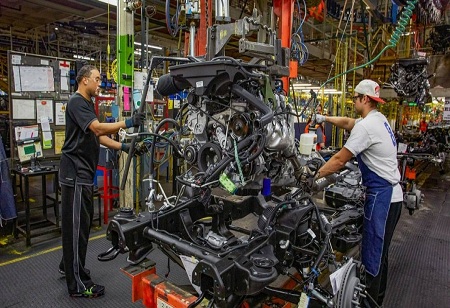
In recent years, the automobile industry has undergone tremendous change, with an increasing emphasis on fuel efficiency and environmental sustainability. Integration of lightweight materials into automobile components is one of the primary tactics used by manufacturers to attain these aims. Fuel consumption may be greatly enhanced by lowering vehicle weight, resulting in fewer greenhouse gas emissions and higher energy efficiency.
Automakers may lower the total weight of cars by substituting heavy elements with lighter-weight ones, which boosts fuel economy. Mazda, for example, replaced heavy steel components with aluminium to lower the weight of their MX-5 Miata by more than 150 pounds, resulting in improved fuel economy. While fuel economy is crucial, it is not the sole consideration for buyers when choosing a car. Other considerations for consumers include safety, comfort, and style.
As a result, while selecting whether or not to utilize lighter-weight materials, automakers must assess the trade-offs between fuel economy and other variables. The amount of gasoline used by a vehicle per unit of distance is referred to as its fuel efficiency. Cars that are more fuel-efficient consume less fuel per mile than cars that are less fuel-efficient. This is due to the fact that a lighter vehicle uses less energy to move; resulting in lower emissions and better fuel efficiency. Let us now look at, how lightweight materials are revolutionizing automotive components for fuel efficiency.
Advanced Composites: A Game-Changer in Vehicle Design
One of the most crucial developments in the quest for lightweight automotive components is the use of advanced composites. These materials combine two or more different constituents, typically a matrix material and a reinforcement fibre, to create a structure that offers exceptional strength-to-weight ratios. Carbon fibre-reinforced polymers (CFRP) and glass fibre-reinforced polymers (GFRP) are prime examples of such composites.
Traditional steel and aluminium components are heavier and more susceptible to corrosion compared to advanced composites. By incorporating CFRP and GFRP in critical parts of the vehicle, manufacturers can significantly reduce weight without compromising on structural integrity. Components such as hoods, roofs, doors, and even entire chassis can be fabricated using advanced composites, making vehicles lighter and more fuel-efficient.
Moreover, composites exhibit excellent fatigue resistance, which enhances the durability and lifespan of automotive components. As these materials become more accessible and cost-effective to produce, their adoption in the automotive industry is expected to accelerate, driving further improvements in fuel efficiency.
Aluminium and Magnesium Alloys: A Shift from Conventional Metals
Aluminium and magnesium alloys have become increasingly popular alternatives to conventional steel in automotive component manufacturing. Both materials possess remarkable strength-to-weight ratios, making them ideal for lightweight applications. Additionally, their inherent corrosion resistance ensures improved longevity, especially in regions with harsh weather conditions.
Aluminium, in particular, has been used extensively in the automotive industry for several years. Its lightweight nature makes it suitable for components like engine blocks, wheels, and transmission casings. More recently, magnesium alloys have garnered attention for their even lower density, offering the potential for further weight reduction in various parts of the vehicle.
The adoption of aluminium and magnesium alloys has not been without challenges, though. Both materials are more expensive than traditional steel, impacting production costs. However, advancements in manufacturing techniques and increased demand are gradually driving down costs, making these lightweight alternatives increasingly viable for mass-produced vehicles.
Innovative Structural Designs: Optimizing Weight and Strength
In addition to utilizing lightweight materials, automotive engineers are focusing on innovative structural designs to optimize weight and strength. Traditionally, vehicle designs favoured robust and over-engineered components to ensure safety. However, with the advent of advanced materials and computer-aided engineering, it is now possible to adopt a more holistic approach to component design.
Simulation and modelling technologies allow engineers to analyze various scenarios, enabling them to identify areas where material can be strategically added or removed without compromising safety. By adopting a design philosophy that takes full advantage of lightweight materials' properties, components can be made more efficient, leading to substantial fuel savings over the vehicle's lifetime.
One prominent example of such design innovation is the concept of the "multi-material vehicle." Instead of relying solely on one material for all components, manufacturers are combining various materials to create a harmonious blend of strength and weight reduction. For instance, combining advanced composites with aluminium or magnesium in a car's body structure allows engineers to achieve optimal weight distribution while maintaining high safety standards.
The car industry's quest for fuel efficiency and sustainability has sparked a revolution in the use of lightweight materials. Advanced composites, aluminium, and magnesium alloys are leading the drive, delivering a paradigm change from traditional steel and significant weight savings in crucial components. Furthermore, novel structural designs that optimize material distribution improve fuel efficiency without compromising safety.
As technical breakthroughs continue to bring down production costs and enhance the availability of lightweight materials, their broad use in popular automobiles becomes more realistic. This progress will surely lead to a future in which fuel-efficient, environmentally friendly automobiles are the norm, contributing to a cleaner and more sustainable transportation scene. Using lightweight materials is not only a fad; it is a crucial step toward a greener automobile industry.
We use cookies to ensure you get the best experience on our website. Read more...